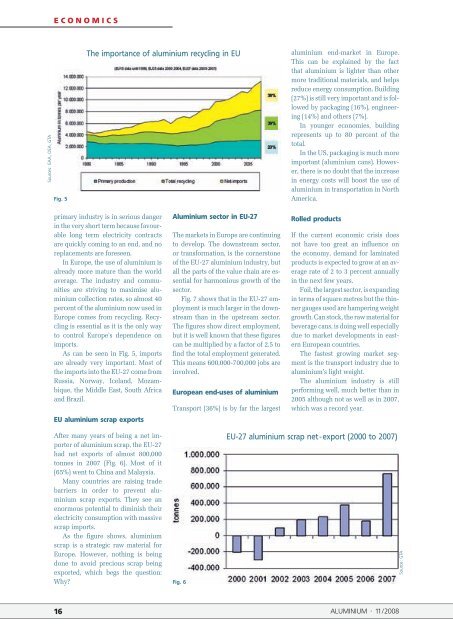SPecIAL - Alu-web.de
SPecIAL - Alu-web.de
SPecIAL - Alu-web.de
Create successful ePaper yourself
Turn your PDF publications into a flip-book with our unique Google optimized e-Paper software.
E c o n o M i c s<br />
Sources: EAA, OEA, GTA<br />
Fig. 5<br />
The importance of aluminium recycling in EU<br />
aluminium endmarket in Europe.<br />
This can be explained by the fact<br />
that aluminium is lighter than other<br />
more traditional materials, and helps<br />
reduce energy consumption. Building<br />
(27%) is still very important and is followed<br />
by packaging (16%), engineering<br />
(14%) and others (7%).<br />
In younger economies, building<br />
represents up to 80 percent of the<br />
total.<br />
In the US, packaging is much more<br />
important (aluminium cans). However,<br />
there is no doubt that the increase<br />
in energy costs will boost the use of<br />
aluminium in transportation in North<br />
America.<br />
primary industry is in serious danger<br />
in the very short term because favourable<br />
long term electricity contracts<br />
are quickly coming to an end, and no<br />
replacements are foreseen.<br />
In Europe, the use of aluminium is<br />
already more mature than the world<br />
average. The industry and communities<br />
are striving to maximise aluminium<br />
collection rates, so almost 40<br />
percent of the aluminium now used in<br />
Europe comes from recycling. Recycling<br />
is essential as it is the only way<br />
to control Europe’s <strong>de</strong>pen<strong>de</strong>nce on<br />
imports.<br />
As can be seen in Fig. 5, imports<br />
are already very important. Most of<br />
the imports into the EU27 come from<br />
Russia, Norway, Iceland, Mozambique,<br />
the Middle East, South Africa<br />
and Brazil.<br />
EU aluminium scrap exports<br />
<strong>Alu</strong>minium sector in EU-27<br />
The markets in Europe are continuing<br />
to <strong>de</strong>velop. The downstream sector,<br />
or transformation, is the cornerstone<br />
of the EU27 aluminium industry, but<br />
all the parts of the value chain are essential<br />
for harmonious growth of the<br />
sector.<br />
Fig. 7 shows that in the EU27 employment<br />
is much larger in the downstream<br />
than in the upstream sector.<br />
The figures show direct employment,<br />
but it is well known that these figures<br />
can be multiplied by a factor of 2.5 to<br />
find the total employment generated.<br />
This means 600,000700,000 jobs are<br />
involved.<br />
European end-uses of aluminium<br />
Transport (36%) is by far the largest<br />
Rolled products<br />
If the current economic crisis does<br />
not have too great an influence on<br />
the economy, <strong>de</strong>mand for laminated<br />
products is expected to grow at an average<br />
rate of 2 to 3 percent annually<br />
in the next few years.<br />
Foil, the largest sector, is expanding<br />
in terms of square metres but the thinner<br />
gauges used are hampering weight<br />
growth. Can stock, the raw material for<br />
beverage cans, is doing well especially<br />
due to market <strong>de</strong>velopments in eastern<br />
European countries.<br />
The fastest growing market segment<br />
is the transport industry due to<br />
aluminium’s light weight.<br />
The aluminium industry is still<br />
performing well, much better than in<br />
2005 although not as well as in 2007,<br />
which was a record year.<br />
After many years of being a net importer<br />
of aluminium scrap, the EU27<br />
had net exports of almost 800,000<br />
tonnes in 2007 (Fig. 6). Most of it<br />
(65%) went to China and Malaysia.<br />
Many countries are raising tra<strong>de</strong><br />
barriers in or<strong>de</strong>r to prevent aluminium<br />
scrap exports. They see an<br />
enormous potential to diminish their<br />
electricity consumption with massive<br />
scrap imports.<br />
As the figure shows, aluminium<br />
scrap is a strategic raw material for<br />
Europe. However, nothing is being<br />
done to avoid precious scrap being<br />
exported, which begs the question:<br />
Why?<br />
Fig. 6<br />
EU-27 aluminium scrap net - export (2000 to 2007)<br />
Source: GTA<br />
16 ALUMINIUM · 11/2008
















